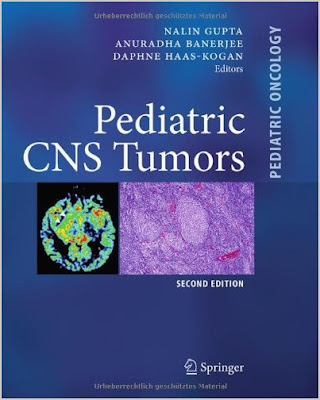Pediatric CNS Tumors (Pediatric Oncology) - 2010 Edition

Pediatric CNS Tumors is a detailed review of childhood brain tumors
with a particular emphasis on providing treatment algorithms for each
tumor type. Controversies and current therapeutic agents under
development are also discussed. The second edition includes expanded chapters on embryonal tumors, rare tumor types, and supportive care for patients with brain tumors.
.From The New England Journal of Medicine Despite the tremendous strides that have been made in developing
successful therapies for many pediatric cancers, certain types of brain
tumors still strike terror in the minds of parents, patients, and
physicians. Pediatric CNS Tumors offers a concise account of the various
histologic types of brain tumors in children and provides clear
descriptions of current management and leading-edge technology. The book
is written at a level of sophistication that will make it useful to
physicians who are directly involved in the care of children with tumors
of the central nervous system. Yet it will also be of interest to a
broader audience, because it integrates information from a wide array of
subspecialties that contribute to the optimal care of a child with a
brain tumor. Because the tumors that arise in the developing brain are
markedly different from tumors in adults and principally involve primary
rather than metastatic disease, this book fills a niche. A helpful
feature, mentioned by the editors, is the roster of authors, who are
affiliated mainly with a single institution, at the University of
California, San Francisco. Rather than leading to provincialism, this
structure makes possible the presentation of a coherent philosophy
regarding complex management decisions. In most institutions, decisions
about treatment for pediatric patients with brain tumors require
coordinated input from several disciplines, and such an approach is
evident in the organization and content of this book. That said, in some
instances, the treatment strategies presented may differ slightly from
practices at other institutions and, as with any complex and evolving
area of medicine, should be interpreted with some flexibility. For
the most part, the book's chapters are devoted to the major histologic
types of pediatric tumors of the central nervous system and include
sections on epidemiology, pathology, imaging, and therapy. This scheme
leads to some degree of repetition in chapters that discuss gliomas but
focus on four anatomical compartments. However, there is merit to
organizing the chapters in such a manner, because, for example, the
biology of brainstem gliomas differs considerably from that of
cerebellar astrocytomas, as do therapies for the two types of tumors.
The format also increases the stand-alone usefulness of various chapters
as reference sources. The final 4 chapters address imaging, surgery,
chemotherapy, and radiation therapy in a more comprehensive manner than
do the 11 chapters on various types of tumors. Since many pediatric
patients with brain tumors are enrolled in cooperative-group clinical
trials, a description of the design and results of previous research
studies is presented in individual chapters. This provides an important
historical perspective. Two aspects of the care of pediatric patients
should have received more comprehensive treatment in this book. The
first is management of long-term follow-up care of survivors. As might
be imagined, the tumor itself, as well as surgery, radiation therapy,
and chemotherapy, can have important effects on the developing brain and
pose lifelong sequelae. A multidisciplinary approach to optimizing the
health and function of survivors is considered a key component of
therapy at many medical centers. A description of the organization of a
comprehensive brain-tumor clinic and the approach to long-term care
would benefit many readers. The second aspect relates to the
ineffectiveness of treatment for several types of newly diagnosed and
recurrent brain tumors. Palliative care has a critical role in the
treatment of patients not only with terminal illnesses, but also with
potentially life-threatening diseases. Perhaps more important, such an
approach can help guide families along a sometimes long and difficult
road. Thus, it is realistic to consider pediatric palliative medicine as
an important component of the management of such cases. These
criticisms aside, this up-to-date book, which includes some of the
exciting recent advances in the molecular pathology of pediatric brain
tumors, is well organized and offers a unified and comprehensive
reference beyond what can be found in textbooks. It will be useful for
practitioners in a broad cross section of medical specialties that
intersect in this fascinating yet sometimes devastating type of cancer.
GET IT HERE
 Related SubjectsPlatinum-Based Drugs in Cancer TherapyGastric Cancer (Contemporary Issues in Cancer Imaging) Handbook of Evidence-Based Radiation Oncology - June 2010 EditionMesotheliomaMalignant Mesothelioma - A Medical Dictionary, Bibliography, and Annotated Research Guide to Internet ReferencesEndosurgery for Cancer (Vademecum)Surgical Oncology (Vademecum)The M.D. Anderson Surgical Oncology Handbook (Feig, M.D. Anderson Surgical Oncology Handbook)
Related SubjectsPlatinum-Based Drugs in Cancer TherapyGastric Cancer (Contemporary Issues in Cancer Imaging) Handbook of Evidence-Based Radiation Oncology - June 2010 EditionMesotheliomaMalignant Mesothelioma - A Medical Dictionary, Bibliography, and Annotated Research Guide to Internet ReferencesEndosurgery for Cancer (Vademecum)Surgical Oncology (Vademecum)The M.D. Anderson Surgical Oncology Handbook (Feig, M.D. Anderson Surgical Oncology Handbook)MKSAP 15 HEMATOLOGY AND ONCOLOGY STUDY MATERIAL
Medstudy 2011: Video Board Review of Internal Medicine
Principles & Practice of Oncology DeVita, Hellman, and Rosenberg's Cancer








